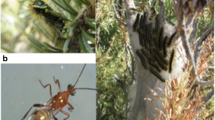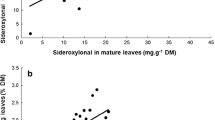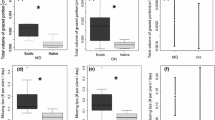Abstract
Few herbivores are well adapted to feeding on all foliage age classes available and most have evolved traits that are attuned to the characteristics of either developing or mature foliage; however, recent evidence has shown a number of insect herbivores that may mix different-aged foliage as a means of enhancing fitness. We carried out a series of laboratory and field experiments to investigate whether larvae of Asian gypsy moth [L. umbrosa (Butler) = L. dispar hokkaidoensis Goldschmidt] (Lepidoptera: Lymantriidae) engage in and benefit from foliage-age dietary mixing in common conifer species that naturally occur in its native range of Hokkaido, Japan. In a laboratory experiment, early instar larvae were observed on both developing and mature foliage when both age classes were available; however, larval survival and weight were highest on hosts with developing foliage available (larch, fir, and pine), whereas all larvae died on spruce where only mature foliage was available. In contrast, laboratory and field experiments indicated that late-instar larvae often consumed both developing and mature foliage on all conifer species studied, although there was general preference bias towards mature foliage. Field bioassays indicated that late-instar larvae provided both foliage age classes (a ‘mixed’ diet) had similar performance to those provided only developing or mature foliage. Results of this study indicate that larvae obtain limited performance benefits from mixing different foliage age-classes into their diet, other than perhaps the benefits accrued from having a broader resource pool available on a single host tree.





Similar content being viewed by others
References
Albert PJ, Bauce E (1994) Feeding preference of fourth- and sixth-instar spruce budworm (Lepidoptera: Tortricidae) larvae for foliage extracts from young and old balsam fir hosts. Env Entomol 23:645–653
Baranchikov YN (1989) Ecological basis of the evolution of host relationships in Eurasian gypsy moth populations. In: Wallner WE, McManus KA (eds) Proceedings Lymantriidae. A comparison of features of new and old world tussock moths. USDA Forest Service. Gen Tech Rpt NE-123, Broomall, pp 319–338
Baranchikov YN, Montgomery ME (1994) Tree suitability for Asian, European and American populations of gypsy moth. USDA Forest Service, Gen Tech Rpt NE-188, p 4
Barbosa P, Krischik VA (1987) Influence of alkaloids on feeding preference of eastern deciduous forest trees by the gypsy moth Lymantria dispar. Am Nat 130:53–69
Barbosa P, Martinat P, Waldvogel M (1986) Development, fecundity, and survival of the herbivore Lymantria dispar and the number of plant species in its diet. Ecol Entomol 11:1–6
Bate-Smith EC (1977) Astringent tannins of Acer species. Phytochemistry 16:1421–1426
Behmer ST (2009) Insect herbivore nutrient regulation. Annu Rev Entomol 54:165–187
Bernays EA, Minkenberg PJM (1997) Insect herbivores: different reasons for being a generalist. Ecology 78:1157–1169
Carroll AL (1999) Phyiological adaptation to temporal variation in conifer foliage by a caterpillar. Can Entomol 131:659–669
Cates RG (1980) Feeding patterns of monophagous, oligophagous, and polyphagous insect herbivores: the effect of resource abundance and plant chemistry. Oecologia 46:22–31
Géri C, Allais JP, Auger MA (1993) Effects of plant chemistry and phenology on sawfly behavior and development. In: Wagner MR, Raffa KF (eds) Sawfly life history adaptations to woody plants. Academic Press, New York, pp 173–210
Gerson EA, Kelsey RG (1998) Variation in Ponderosa (Pinus ponderosa) and lodgepole pine (P. contorta) foliage from central Oregon. J Chem Ecol 24:815–827
Hägele BF, Rowell-Rahier M (1999) Dietary mixing in three generalist herbivores: nutrient complementation or toxin dilution? Oecologia 119:521–533
Hajek AE, Tobin PC (2009) North American eradications of Asian and European gypsy moth. In: Hajek AE, Glare TR, O’Callaghan M (eds) Use of microbes for control and eradication of invasive arthropods. Springer, Berlin, pp 71–89
Hochuli DF (2001) Insect herbivory and ontogeny: How do growth and development influence feeding behaviour, morphology and host use? Austral Ecol 26:563–570
Hunter AF, Lechowicz MJ (1992) Host foliage acceptability during the dispersal period of gypsy moth larvae. Oecologia 89:316–323
Johns RC, Quiring DT (2010) Spatial heterogeneity within an evergreen conifer promotes foliage-age dietary mixing by a specialist herbivore. Anim Behav 80:659–666
Johns RC, Ostaff DP, Quiring DT (2006) Sampling methods for evaluating yellowheaded spruce sawfly density and defoliation in juvenile black spruce. J Acad Entomol Soc 2:1–13
Johns RC, Quiring DT, Lapointe R, Lucarotti CJ (2009) Foliage-age mixing within balsam fir increases the fitness of a generalist caterpillar. Ecol Entomol 34:624–631
Johns RC, Ozaki K, Tobita H (2012) Dietary mixing within the crown of a deciduous conifer enhances the fitness of a specialist sawfly. Anim Behav 84:1393–1400
Joseph G, Kelsey RG (1994) Acceptibility and suitability of Douglas-fir as a secondary host for gypsy moth (Lepidoptera: Lymantriidae). Pop Ecol 23:396–405
Julkanen-Tiitto R (1985) Phenoloic constituents in the leaves of northern willows: methods for the analysis of certain phenolics. J Agr Food Chem 33:213–217
Karban R, Baldwin IT (1997) Induced responses to herbivory. University of Chicago Press, Chicago
Kishida Y (2011) Lymantriidae. In: Kishida Y (ed) The standards of moths in Japan, vol 2. Gakken Education Publishing, Tokyo, pp 139–147
Kulman HM (1971) Effects of insect defoliation on growth and mortality of trees. Annu Rev Entomol 16:289–324
Lazarević J, Perić-Mataruga V, Stojković B, Tucić N (2002) Adaptation of the gypsy moth to an unsuitable host plant. Entomol Exp Appl 102:75–86
Leonard DE (1981) Bioecology of gypsy moth. The gypsy moth: Research toward Integrated Pest Management. In: Doane CC, McManus ML (eds) USDA Technical Bulletin 1584. US Department of Agriculture, Washington, pp 9–30
Liebhold AM, Gottschalk KG, Muzika R, Montgomery ME, Young R, O’Day K, Kelly B (1995) Suitability of North american tree species to the gypsy moth: a summary of field and laboratory tests. USDA General Technical Report NE-211, USDA, Forest Service, Delaware
Lindroth RL, Anson BD, Weisbrod AV (1990) Effects of protein and juglone on gypsy moths: growth performance and detoxification enzyme activity. J Chem Ecol 16:2533–2547
Matsuki M, Kay M, Serin J, Floyd R, Scott JK (2001) Potential risk of accidental introduction of Asian gypsy moth (Lymantria dispar) to Australasia: effects of climatic conditions and suitability of native plants. Agr For Entomol 3:305–320
Mody K, Unsicker SB, Linsenmair KE (2007) Fitness related diet-mixing by intraspecific host-plant-switching of specialist insect herbivores. Ecology 88:1012–1020
Moreau G, Quiring DT, Eveleigh ES, Bauce E (2003) Advantages of a mixed diet: feeding on several foliar age classes increases the performance of a specialist insect herbivore. Oecologia 135:391–399
Ohigashi H, Wagner MR, Matsumura F, Benjamin DM (1981) Chemical basis of differential feeding behavior of the larch sawfly, Pristophora erichsonii (Hartig). J Chem Ecol 7:599–614
Onodera K, Hara H (2010) Defoliation of Sakhalin fir by gypsy moth that outbreaked in multi-layered plantation. Koshunai-kihou 158:6–9 (in Japanese)
Parsons K, Quiring DT, Piene H, Farrell J (2003) Temporal patterns of balsam fir sawfly defoliation and growth loss in young balsam fir. For Ecol Manage 184:33–46
Piene H (1980) Effects of insect defoliation on growth and foliar nutrients of young balsam fir. For Sci 26:665–673
Piene H (1991) The sensitivity of young white spruce to spruce budworm defoliation. North J Appl For 8:168–171
Pinault L, Thurston G, Quiring DT (2009) The interaction of foliage and larval age influence the preference and performance of a geometrid caterpillar. Can Entomol 141:136–144
Pogue MG, Schaefer PW (2007) A review of selected species of Lymantria Huber (1819) (Lepidoptera: Noctuidae: Lymantriinae) from subtropical and temperate regions of Asia, including the descriptions of three new species, some potentially invasive to North America. US Department of Agriculture Forest Health Technology Enterprise Team, Morgantown
Raupp MJ, Werren JH, Clifford S (1988) Effects of short-term phonological changes in leaf suitability on the survivorship, growth, and development of gypsy moth (Lepidoptera: Lymantriidae) larvae. Env Entomol 17:316–319
Rossiter MC (1987) Use of a secondary host by non-outbreak populations of the gypsy moth. Ecology 68:857–868
SAS Institute Inc (1999) The SAS system version 8 for Windows. SAS Institute, Cary
Sheppard CA, Friedman S (1990) Influence of host plant, foliar phenology and larval dietary history on Lymantria dispar larval nutritional indices. Entomol Exp Appl 55:247–255
Shields VD, Rodgers EJ, Arnold NS, Williams D (2006) Feeding responses to selected alkaloids by gypsy moth larvae, Lymantria dispar (L.). Naturwissenschaften 93:127–130
Singer MS, Bernays EA, Carriere Y (2002) The interplay between nutrient balancing and toxin dilution in foraging by a generalist insect herbivore. Anim Behav 64:629–643
Stamp NE, Bowers MD (1990) Variation in food quality and temperature constrains the foraging of gregarious caterpillars. Ecology 7:1031–1039
Stoyenoff JL, Witter JA, Montgomery ME, Chilcote CA (1994) Effects of host switching on gypsy moth (Lymantria dispar L.) under field conditions. Oecologia 97:143–157
Acknowledgments
We thank A. Komatsu for processing foliage for chemical analyses. We are also grateful to T. Yamaguchi for allowing us to use his Japanese larch stand for manipulative experiments, and to D. Carleton, E. Moise, D. Quiring, C. Simpson, J. Sweeney, Z. Sylvain, and several anonymous reviewers for comments on earlier versions of the manuscript. Financial support was provided through the Japanese Society for the Promotion of Science and from a JSPS Postdoctoral Fellowship for Foreign Researchers (25252030 and 19.07779).
Author information
Authors and Affiliations
Corresponding author
About this article
Cite this article
Johns, R.C., Tobita, H., Hara, H. et al. Adaptive advantages of dietary mixing different-aged foliage within conifers for a generalist defoliator. Ecol Res 30, 793–802 (2015). https://doi.org/10.1007/s11284-015-1280-4
Received:
Accepted:
Published:
Issue Date:
DOI: https://doi.org/10.1007/s11284-015-1280-4




